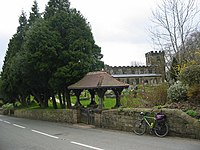Pentrich, Derbyshire
| Pentrich | |
|---|---|
 Pentrich Church |
|
| Pentrich shown within Derbyshire | |
| Population | 191 (2011) |
| OS grid reference | SK389525 |
| District | |
| Shire county | |
| Region | |
| Country | England |
| Sovereign state | United Kingdom |
| Post town | RIPLEY |
| Postcode district | DE5 |
| Dialling code | 01773 |
| Police | Derbyshire |
| Fire | Derbyshire |
| Ambulance | East Midlands |
| EU Parliament | East Midlands |
| UK Parliament | |
Pentrich is a small village and civil parish between Belper and Alfreton in Amber Valley, Derbyshire, England. The population of the civil parish taken at the 2011 Census was 191.
The village gave its name to the Pentrich rising, an armed uprising which occurred on the night of 9/10 June 1817. The name is controversial. While much of the planning took place in Pentrich, two of the three ringleaders were from South Wingfield and the other was from Sutton in Ashfield; the 'revolution' itself started from Hunt's Barn in South Wingfield, and the only person killed died in Wingfield Park.
A gathering of some two or three hundred men (stockingers, quarrymen and iron workers), led by Jeremiah Brandreth ('The Nottingham Captain'), (an unemployed stockinger, and claimed, without substantiation, by Gyles Brandreth as an ancestor), set out from South Wingfield to march to Nottingham. They were lightly armed with pikes, scythes and a few guns, which had been hidden in a quarry in Wingfield Park, and had a set of rather unfocussed revolutionary demands, including the wiping out of the National Debt.
The organizer of the event turned out to be a government spy, who became known as Oliver the Spy, and the uprising was quashed soon after it began. Three men were hanged for their participation in the uprising, including Brandreth.
Whilst St Matthew's Church is not mentioned in the Domesday book (1086), a charter of 1154–9 confirms the gift of the church of Pentrich to the canons of Darley Abbey. Of this Norman church or one which shortly after replaced it the five arcades separating the aisles from the nave, parts of the west wall and south aisle and lower part of the tower remain.
The tower was made higher in the late 14th century and the two aisles were rebuilt. Around 1430 a new pointed chancel arch was built, retaining the earlier capitals and piers and a clerestory was added. The tracery of the east window suggests a date of 1420–50.
...
Wikipedia

